Page 75 of 553
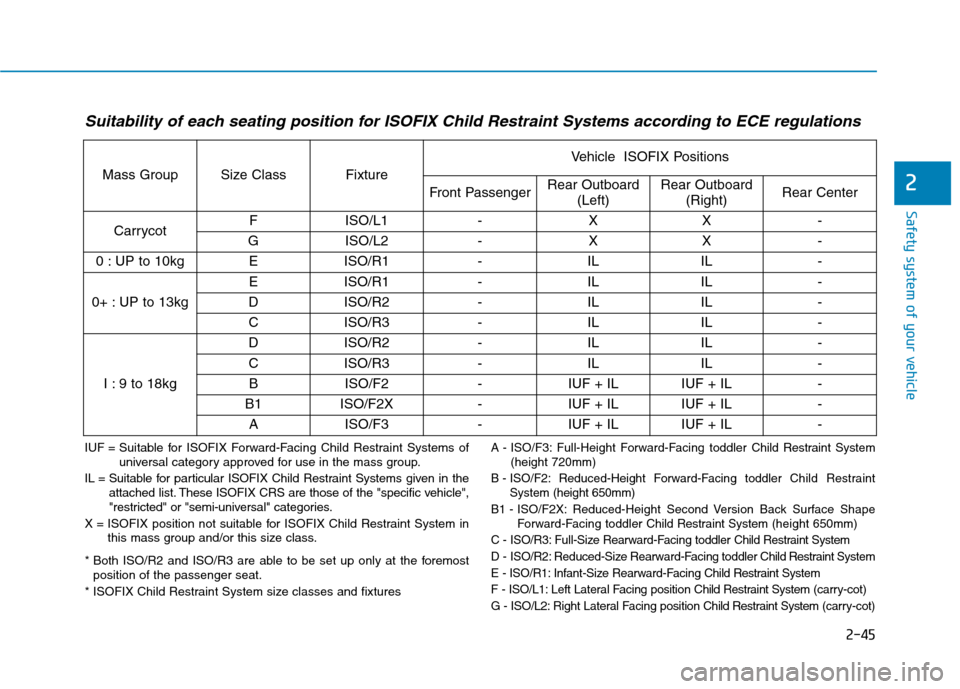
2-45
Safety system of your vehicle
2
Suitability of each seating position for ISOFIX Child Restraint Systems according to ECE regulations
IUF = Suitable for ISOFIX Forward-Facing Child Restraint Systems ofuniversal category approved for use in the mass group.
IL = Suitable for particular ISOFIX Child Restraint Systems given in the attached list. These ISOFIX CRS are those of the "specific vehicle",
"restricted" or "semi-universal" categories.
X = ISOFIX position not suitable for ISOFIX Child Restraint System in this mass group and/or this size class.
* Both ISO/R2 and ISO/R3 are able to be set up only at the foremost position of the passenger seat.
* ISOFIX Child Restraint System size classes and fixturesA - ISO/F3: Full-Height Forward-Facing toddler Child Restraint System
(height 720mm)
B - ISO/F2: Reduced-Height Forward-Facing toddler Child Restraint
System (height 650mm)
B1 - ISO/F2X: Reduced-Height Second Version Back Surface Shape Forward-Facing toddler Child Restraint System(height 650mm)
C - ISO/R3: Full-Size Rearward-Facing toddler Child Restraint System
D - ISO/R2: Reduced-Size Rearward-Facing toddler Child Restraint System
E - ISO/R1: Infant-Size Rearward-Facing Child Restraint System
F - ISO/L1: Left Lateral Facing position Child Restraint System(carry-cot)
G - ISO/L2: Right Lateral Facing position Child Restraint System (carry-cot)
Mass Group Size Class Fixture Vehicle ISOFIX Positions
Front Passenger Rear Outboard
(Left) Rear Outboard
(Right) Rear Center
Carrycot F ISO/L1 - X X -
G ISO/L2 - X X -
0 : UP to 10kg E ISO/R1 - IL IL -
0+ : UP to 13kg E ISO/R1 - IL IL -
D ISO/R2 - IL IL -
C ISO/R3 - IL IL -
I : 9 to 18kg D ISO/R2 - IL IL -
C ISO/R3 - IL IL -
B ISO/F2 - IUF + IL IUF + IL -
B1 ISO/F2X - IUF + IL IUF + IL - A ISO/F3 - IUF + IL IUF + IL -
Page 76 of 553
2-46
Safety system of your vehicle
Securing a Child RestraintSystem with a lap/shoulder belt
When not using the ISOFIX system,
all Child Restraint Systems must besecured to a rear seat with the lap
part of a lap/shoulder belt.
Installing a Child Restraint System
with a lap/shoulder belt
To install a Child Restraint System
on the rear seats, do the following:
1. Place the Child Restraint System on a rear seat and route the lap/ shoulder belt around or through the
Child Restraint System, following
the Child Restraint System manu-
facturer’s instructions.
Make sure the seat belt webbing is not twisted. Information
When using the rear center seat belt,
you should also refer to the “3-point
Rear Center Seat Belt” in this chapter.
i
OLMB033044
Page 77 of 553
2-47
Safety system of your vehicle
2
2. Fasten the lap/shoulder belt latchinto the buckle. Listen for the dis-
tinct “click” sound.
Information
Position the release button so that it is
easy to access in case of an emergency. 3. Remove as much slack from the
belt as possible by pushing down
on the Child Restraint System while
feeding the shoulder belt back into
the retractor.
4. Push and pull on the Child Restraint System to confirm that the seat belt
is holding it firmly in place.
If your Child Restraint System manu-
facturer recommends the use of atop-tether with the lap/shoulder belt,see page 2-44. To remove the Child Restraint System,
press the release button on the buckleand then pull the lap/shoulder belt out
of the Child Restraint System and
allow the seat belt to retract fully.
i
OLMB033045OLMB033046
Page 78 of 553
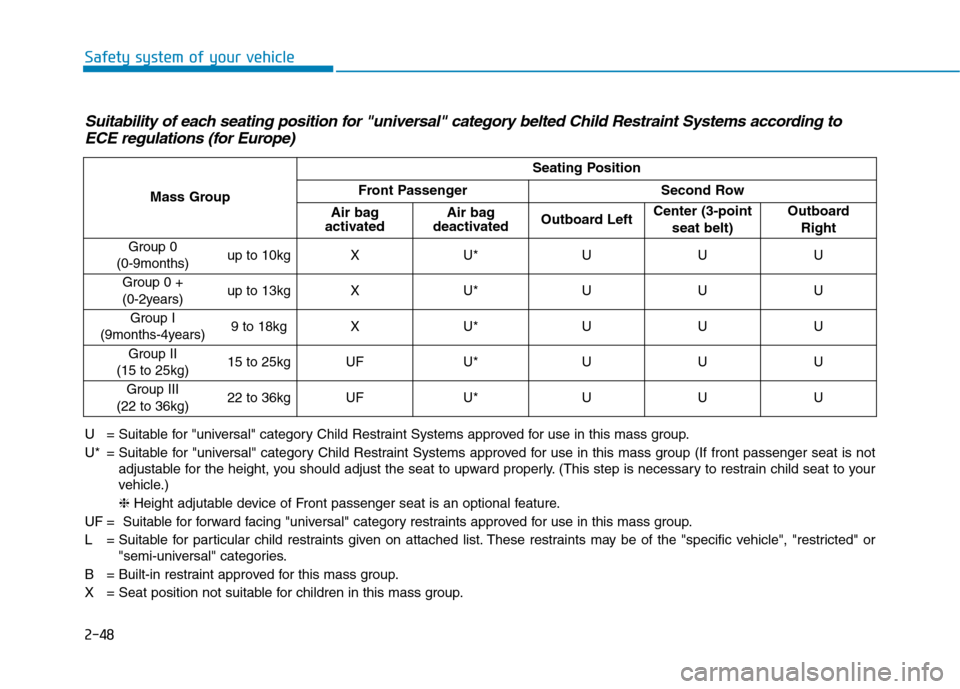
2-48
Safety system of your vehicle
Suitability of each seating position for "universal" category belted Child Restraint Systems according toECE regulations (for Europe)
U = Suitable for "universal" category Child Restraint Systems approved for use in this mass group.
U* = Suitable for "universal" category Child Restraint Systems approved for use in this mass group (If front passenger seat is n ot
adjustable for the height, you should adjust the seat to upward properly. (This step is necessary to restrain child seat to your
vehicle.)
❈ Height adjutable device of Front passenger seat is an optional feature.
UF = Suitable for forward facing "universal" category restraints approved for use in this mass group.
L = Suitable for particular child restraints given on attached list. These restraints may be of the "specific vehicle", "restrict ed" or
"semi-universal" categories.
B = Built-in restraint approved for this mass group.
X = Seat position not suitable for children in this mass group.
Mass Group
Seating Position
Front PassengerSecond Row
Air bag
activatedAir bag
deactivatedOutboard LeftCenter (3-point
seat belt)Outboard Right
Group 0
(0-9months)up to 10kgXU*UUU
Group 0 +
(0-2years)up to 13kgXU*UUU
Group I
(9months-4years)9 to 18kgXU*UUU
Group II
(15 to 25kg)15 to 25kgUFU*UUU
Group III
(22 to 36kg)22 to 36kgUFU*UUU
Page 79 of 553
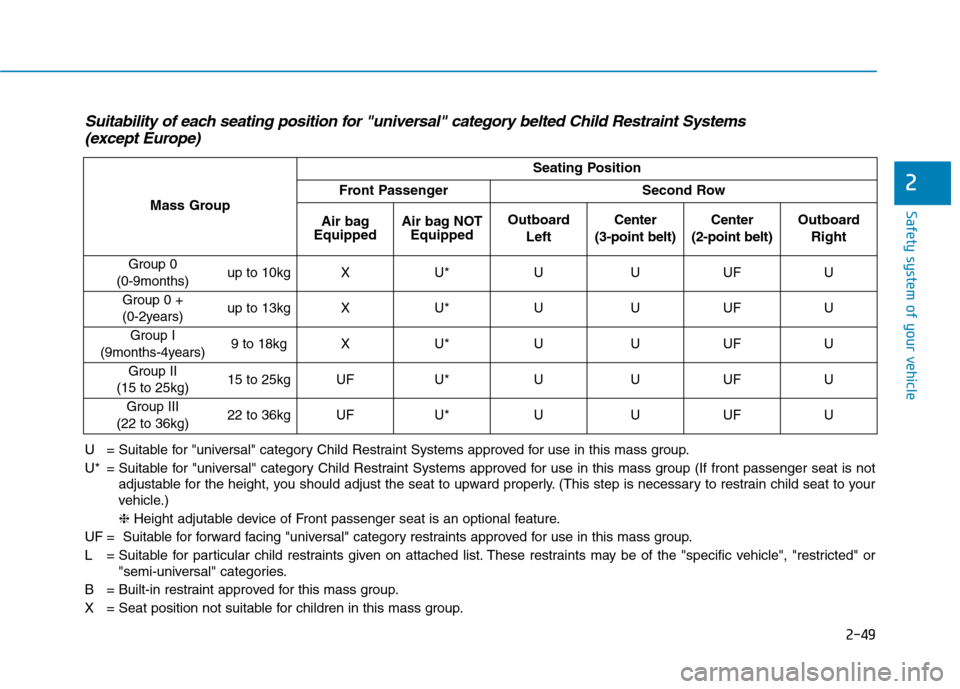
2-49
Safety system of your vehicle
2
Suitability of each seating position for "universal" category belted Child Restraint Systems (except Europe)
U = Suitable for "universal" category Child Restraint Systems approved for use in this mass group.
U* = Suitable for "universal" category Child Restraint Systems approved for use in this mass group (If front passenger seat is n ot
adjustable for the height, you should adjust the seat to upward properly. (This step is necessary to restrain child seat to your
vehicle.)
❈ Height adjutable device of Front passenger seat is an optional feature.
UF = Suitable for forward facing "universal" category restraints approved for use in this mass group.
L = Suitable for particular child restraints given on attached list. These restraints may be of the "specific vehicle", "restrict ed" or
"semi-universal" categories.
B = Built-in restraint approved for this mass group.
X = Seat position not suitable for children in this mass group.
Mass Group
Seating Position
Front PassengerSecond Row
Air bag
EquippedAir bag NOT EquippedOutboard
LeftCenter
(3-point belt)Center
(2-point belt)Outboard Right
Group 0
(0-9months)up to 10kgXU*UUUFU
Group 0 +
(0-2years)up to 13kgXU*UUUFU
Group I
(9months-4years)9 to 18kgXU*UUUFU
Group II
(15 to 25kg)15 to 25kgUFU*UUUFU
Group III
(22 to 36kg)22 to 36kgUFU*UUUFU
Page 80 of 553
2-50
Safety system of your vehicle
i-Size Child Restraint Systems according to ECE regulations (for Europe)
i-U : Suitable for i-Size "universal" Child Restraint Systems forward and rearward-facing
i-UF : Suitable for forward-facing i-Size "universal" Child Restraint Systems only
X : Seat position not suitable for i-size CRS.
Mass Group
Seating Position
Front passengerOutboardSecond Row
Outboard LeftCenter Outboard Right
i-size Child Restraint SystemsXi-UXi-U
Page 83 of 553
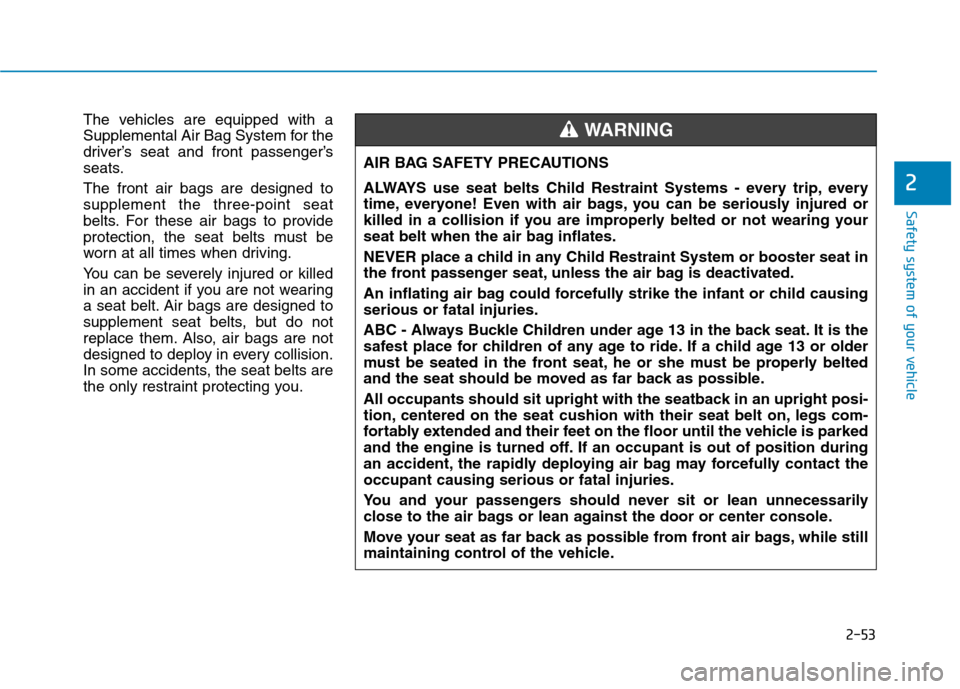
2-53
Safety system of your vehicle
2
The vehicles are equipped with a
Supplemental Air Bag System for the
driver’s seat and front passenger’s
seats. The front air bags are designed to supplement the three-point seat
belts. For these air bags to provide
protection, the seat belts must be
worn at all times when driving.
You can be severely injured or killed
in an accident if you are not wearing
a seat belt. Air bags are designed to
supplement seat belts, but do not
replace them. Also, air bags are not
designed to deploy in every collision.
In some accidents, the seat belts are
the only restraint protecting you.AIR BAG SAFETY PRECAUTIONS
ALWAYS use seat belts Child Restraint Systems - every trip, every
time, everyone! Even with air bags, you can be seriously injured or
killed in a collision if you are improperly belted or not wearing your
seat belt when the air bag inflates.
NEVER place a child in any Child Restraint System or booster seat in
the front passenger seat, unless the air bag is deactivated.
An inflating air bag could forcefully strike the infant or child causing serious or fatal injuries.
ABC - Always Buckle Children under age 13 in the back seat. It is the
safest place for children of any age to ride. If a child age 13 or older
must be seated in the front seat, he or she must be properly belted
and the seat should be moved as far back as possible.
All occupants should sit upright with the seatback in an upright posi-
tion, centered on the seat cushion with their seat belt on, legs com-
fortably extended and their feet on the floor until the vehicle is parked
and the engine is turned off. If an occupant is out of position during
an accident, the rapidly deploying air bag may forcefully contact theoccupant causing serious or fatal injuries.
You and your passengers should never sit or lean unnecessarily
close to the air bags or lean against the door or center console.
Move your seat as far back as possible from front air bags, while still
maintaining control of the vehicle.WARNING
Page 88 of 553
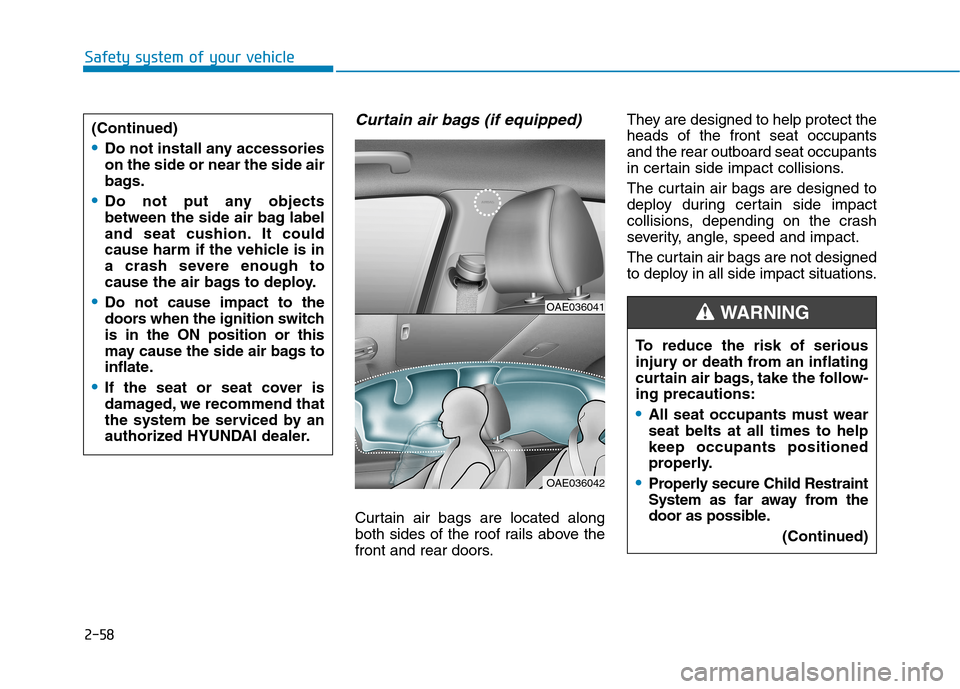
2-58
Safety system of your vehicle
Curtain air bags (if equipped)
Curtain air bags are located along
both sides of the roof rails above the
front and rear doors.They are designed to help protect theheads of the front seat occupantsand the rear outboard
seat occupants
in certain side impact collisions.
The curtain air bags are designed to
deploy during certain side impact
collisions, depending on the crash
severity, angle, speed and impact.
The curtain air bags are not designed
to deploy in all side impact situations.
(Continued)
Do not install any accessories on the side or near the side air
bags.
Do not put any objects
between the side air bag label
and seat cushion. It could
cause harm if the vehicle is in
a crash severe enough to
cause the air bags to deploy.
Do not cause impact to the
doors when the ignition switchis in the ON position or this
may cause the side air bags to
inflate.
If the seat or seat cover is
damaged, we recommend that
the system be serviced by an
authorized HYUNDAI dealer.
OAE036041
OAE036042
To reduce the risk of serious
injury or death from an inflating
curtain air bags, take the follow-ing precautions:
All seat occupants must wear seat belts at all times to helpkeep occupants positioned
properly.
Properly secure Child Restraint
System as far away from the
door as possible.
(Continued)
WARNING